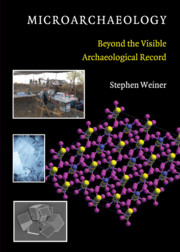Book contents
- Frontmatter
- Contents
- Preface
- 1 Archaeology, Archaeological Science, and Microarchaeology
- 2 Information Embedded in the Microscopic Record
- 3 Completeness of the Archaeological Record
- 4 Common Mineral Components of the Archaeological Record
- 5 Biological Materials: Bones and Teeth
- 6 Biological Materials: Phytoliths, Diatoms, Eggshells, Otoliths, and Mollusk Shells
- 7 Reconstructing Pyrotechnological Processes
- 8 Biological Molecules and Macromolecules: Protected Niches
- 9 Ethnoarchaeology of the Microscopic Record: Learning from the Present
- 10 Absolute Dating: Assessing the Quality of a Date
- 11 Reading the Microscopic Record On-Site
- 12 Infrared Spectroscopy in Archaeology
- Appendix A Identifying Minerals Using Microchemical Analysis
- Appendix B Identifying Minerals and Compounds Using Infrared Spectra: Table of Standard Minerals and Compounds for Which Infrared Spectra Are Available
- References
- Index
- Plates section
3 - Completeness of the Archaeological Record
Published online by Cambridge University Press: 05 June 2012
- Frontmatter
- Contents
- Preface
- 1 Archaeology, Archaeological Science, and Microarchaeology
- 2 Information Embedded in the Microscopic Record
- 3 Completeness of the Archaeological Record
- 4 Common Mineral Components of the Archaeological Record
- 5 Biological Materials: Bones and Teeth
- 6 Biological Materials: Phytoliths, Diatoms, Eggshells, Otoliths, and Mollusk Shells
- 7 Reconstructing Pyrotechnological Processes
- 8 Biological Molecules and Macromolecules: Protected Niches
- 9 Ethnoarchaeology of the Microscopic Record: Learning from the Present
- 10 Absolute Dating: Assessing the Quality of a Date
- 11 Reading the Microscopic Record On-Site
- 12 Infrared Spectroscopy in Archaeology
- Appendix A Identifying Minerals Using Microchemical Analysis
- Appendix B Identifying Minerals and Compounds Using Infrared Spectra: Table of Standard Minerals and Compounds for Which Infrared Spectra Are Available
- References
- Index
- Plates section
Summary
It is not easy to forget that the familiar macroscopic archaeological record is missing a huge amount of information when compared to the same site when occupied. Any interpretation of the excavated record thus requires a serious assessment of what is missing, and in particular, differentiating between what is missing because it was never present or because of degradation (diagenesis). The microscopic record is, in many respects, the key to understanding the missing part of the archaeological record. The focus of this chapter is on better understanding the completeness of the whole archaeological record through the microscopic record.
Darwin (1859, chap. 9) addressed the issue of completeness in the context of paleontology when he wrote about the “imperfection of the fossil record.” Darwin recognized that the fossil record was a direct source of information for evaluating his theory of evolution and was concerned that an uncritical reading of this record would compromise his hypothesis. He was particularly concerned with the fact that fossils rarely show any morphological change over time and hence contradicted his predictions. Gaps exist in the fossil record, and any reading of the record obviously needs to take this into account. In fact, it is not only the gaps that can cause confusion, but also the quality of the record: the proportion of past life that is not recorded, the information content of the record that is preserved, the bias that this introduces, and so on (Kidwell and Holland, 2002).
- Type
- Chapter
- Information
- MicroarchaeologyBeyond the Visible Archaeological Record, pp. 46 - 67Publisher: Cambridge University PressPrint publication year: 2010



